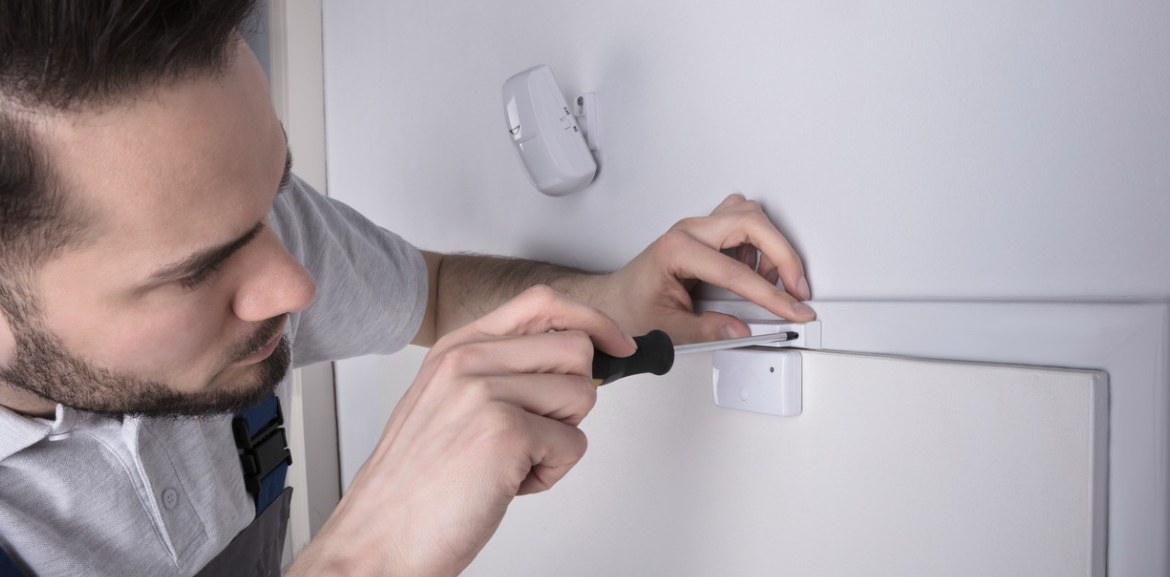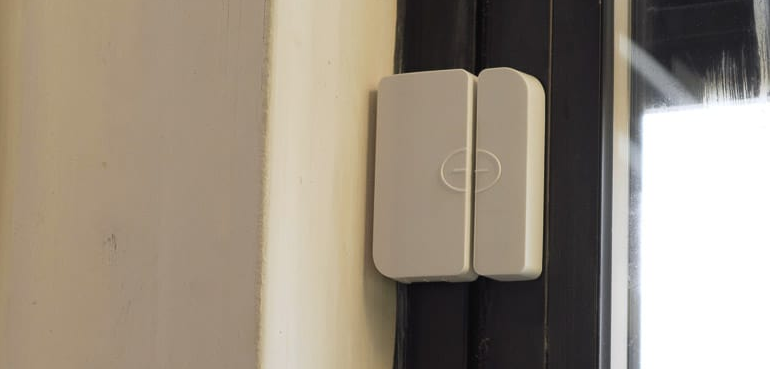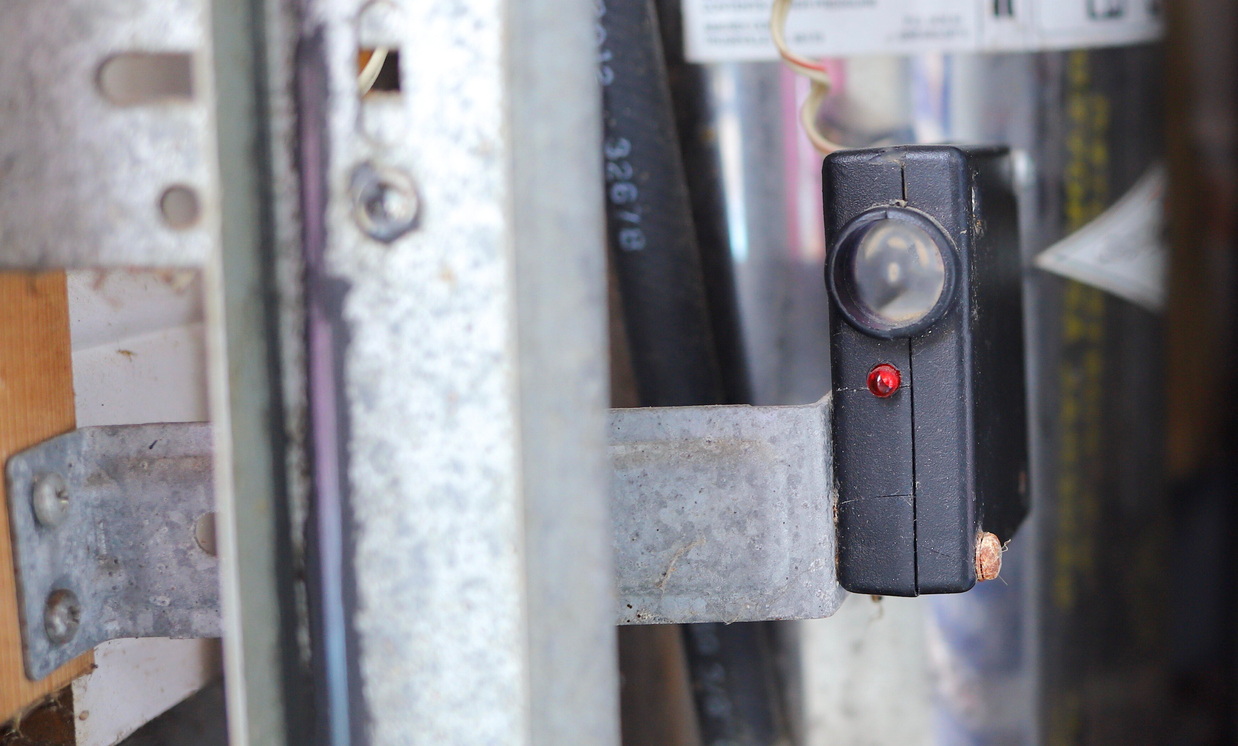Door sensors operate by creating an electrical circuit that breaks when a door is opened, triggering an alert or action.
Types of Door Sensors
Contact Sensors
Contact sensors are the most basic form of door sensors and are often used in residential security systems. These sensors consist of two main parts: a magnet and a sensor. The magnet is usually placed on the door while the sensor is affixed to the door frame. When the door is closed, the magnet and sensor align, creating a closed circuit. Opening the door breaks this circuit, triggering an alert.

Components
Magnetic strip
Reed switch sensor
Battery or power source
Working Mechanism When the door is opened, the magnetic field is disturbed, and the sensor sends an alert to the central control system.
Common Uses
Home security systems
Office buildings
Storage units
Advantages and Limitations
Advantages: Simple design, low cost, easy to install.
Limitations: Limited range, susceptible to tampering.
Wikipedia: Magnetic Contact Switch
Motion Sensors
Motion sensors in doorways work by detecting changes in heat or movement within a predefined area. These are commonly found in commercial settings where high traffic is expected.
Components
Passive Infrared Sensor (PIR)
Ultrasonic transducers
Microwave emitters
Working Mechanism Sensors detect changes in heat or movement and send alerts or trigger actions like door opening.
Common Uses
Retail shops
Malls
Automated door systems
Advantages and Limitations
Advantages: High sensitivity, suitable for high-traffic areas.
Limitations: Can be triggered accidentally, more expensive.
Proximity Sensors
Proximity sensors detect the presence or absence of an object within a specific range. They are often used in industrial settings or secure access areas.
Components
Inductive sensor
Capacitive sensor
Optical sensor
Working Mechanism The sensor triggers when an object comes within a predetermined range, without requiring physical contact.
Common Uses
Secure access areas
Industrial automation
Parking garages
Advantages and Limitations
Advantages: Non-contact sensing, adjustable range.
Limitations: Can be sensitive to environmental factors like temperature and humidity.
Infrared Sensors
Infrared sensors use infrared light to detect objects or movement. They are commonly used in advanced security systems and automation.
Components
Infrared LED
Photodiode or phototransistor
Signal processing unit
Working Mechanism Infrared radiation is emitted, and the sensor measures the changes in the levels of absorbed or reflected radiation to detect presence or movement.
Common Uses
Advanced security systems
Automated doors in hospitals
Energy-efficient homes
Advantages and Limitations
Advantages: High accuracy, can work in the dark.
Limitations: Can be affected by other sources of infrared radiation, relatively expensive.
Mechanism of Operation
Electrical Circuits Involved
Electrical circuits form the backbone of any door sensor system. For example, in a basic magnetic contact sensor, a simple electrical circuit connects the reed switch to a control panel. When the door is closed, the magnet and reed switch align to complete the circuit. Opening the door breaks this circuit, signaling the control panel to take predefined actions such as sounding an alarm.
Components
Reed switch
Resistor
Power supply
Working Mechanism The electrical circuit remains closed as long as the door stays closed. Once the door opens, the circuit breaks, causing an alert to be sent to the central control system.
Examples
Home security systems
Commercial building access systems
Sensor-Door Communication
Communication between the sensor and the door unit is crucial for the effective functioning of any sensor system. In more advanced systems like smart door sensors, wireless communication protocols such as Zigbee or Wi-Fi enable real-time alerts and remote monitoring.
Components
Communication protocol
Central control unit
Wireless transmitter and receiver
Working Mechanism The sensor collects data and sends it to the central control unit using a predefined communication protocol. This could be as simple as a wired connection or as complex as a Wi-Fi-enabled smart system.
Examples
Wi-Fi-enabled home security
Zigbee-based industrial sensors
Sensor Data Processing
The data collected by the sensor usually requires some form of processing. This may involve straightforward actions like triggering an alarm or more complex procedures like sending a notification to your smartphone. In smart systems, data processing often involves cloud computing for additional functionality like historical data analysis and integration with other smart devices.
Components
Microcontroller or microprocessor
Data storage
Data processing software
Working Mechanism The central control unit receives the sensor data and processes it according to predefined rules. This could mean sounding an alarm, sending a text alert, or even initiating a call to emergency services.
Examples
Home security systems with mobile app notifications
Commercial systems integrated with building management software
Applications
Home Security
Door sensors play a crucial role in home security systems. Whether you live in an apartment or a multi-story house, door sensors can provide the first line of defense against unauthorized entry. They are typically easy to install and offer various ways to alert homeowners, from traditional alarms to smartphone notifications.
Types of Sensors Used
Magnetic Contact Sensors
Motion Sensors
Common Features
Real-time alerts
Remote monitoring via smartphones
Integration with security cameras
Examples
Smart home security systems
Basic door alarms
Commercial Spaces
In commercial spaces like office buildings and retail shops, door sensors serve multiple purposes beyond just security. They can help to manage energy consumption by turning off lights when doors are closed or even assist in crowd management.
Types of Sensors Used
Infrared Sensors
Proximity Sensors
Common Features
Automated lighting controls
Traffic analytics for retail spaces
Examples
Retail analytics solutions
Office building access systems
Wikipedia: Building Automation

Healthcare Facilities
Healthcare facilities present unique challenges that door sensors are well-suited to address. In environments where hygiene and patient safety are paramount, touchless sensors using infrared or proximity technology can significantly reduce the risk of cross-contamination.
Types of Sensors Used
Motion Sensors
Infrared Sensors
Common Features
Hands-free door opening
Restricted access to sensitive areas
Examples
Hospitals
Laboratories
Wikipedia: Healthcare in the United States
Public Transit
Door sensors are an essential component in public transit systems, especially in trains and buses, where they ensure safe and efficient boarding and alighting. Sensors here need to be extremely reliable to handle the high volume of passengers and varying environmental conditions.
Types of Sensors Used
Optical Sensors
Proximity Sensors
Common Features
Automatic door opening and closing
Safety mechanisms to prevent trapping
Examples
Metro train systems
City buses
Installation Procedures
Choosing the Right Sensor
The first step in any door sensor installation is to choose the right type of sensor for your specific needs. Factors such as the purpose of the sensor (security, automation, etc.), the environment in which it will operate, and your budget all play a role in this decision.
Considerations
Security requirements
Environmental conditions
Budget constraints
Tips for Making the Right Choice
For home security, a basic magnetic contact sensor may suffice.
In commercial or healthcare settings, you might opt for infrared or proximity sensors for added functionality.
Installation Steps
Once you’ve chosen the appropriate sensor, the next step is the actual installation. While some sensors require professional installation, many are designed for easy DIY setup.
Basic Steps for Magnetic Contact Sensor
Place the sensor on the door frame and the magnet on the door.
Connect the sensor to the control unit using wires or through wireless methods.
Test the sensor to ensure it’s working correctly.
Basic Steps for Infrared Sensor
Mount the sensor at the desired height.
Connect it to the power source and control unit.
Angle it to cover the desired area for detection.

Calibration
After installation, calibration ensures that your sensor operates as expected. This often involves adjusting sensitivity settings to prevent false alarms or ineffective detection.
Calibration for Magnetic Contact Sensors
Adjust the gap between the magnet and sensor for optimal performance.
Calibration for Motion Sensors
Test different sensitivity levels to avoid false alarms due to pets or small movements.
Calibration Tools
Screwdrivers for physical adjustments
Software interface for digital adjustments
What types of door sensors are available?
How much does a basic door sensor cost?
What is the energy consumption of these sensors?
How long does a door sensor last?
What is the range of motion sensors?
What materials are commonly used in door sensors?
How long does it take to install a door sensor?
What are the main advantages and drawbacks of using door sensors?
